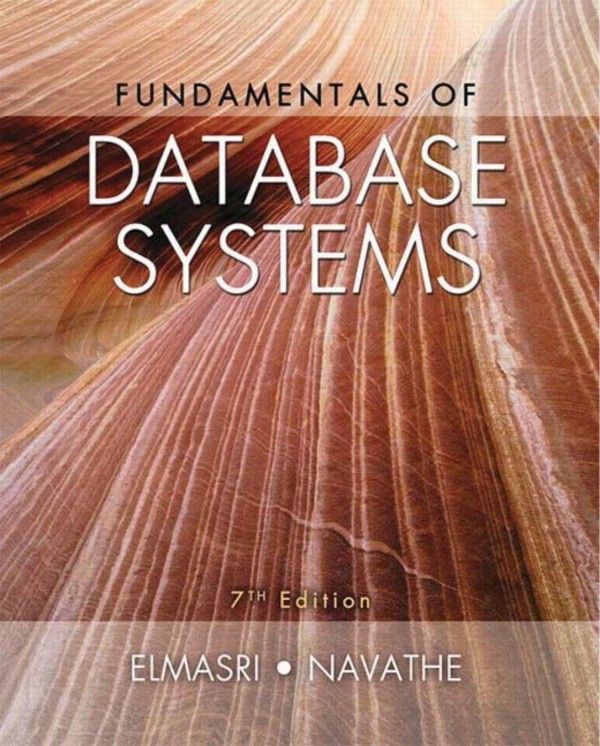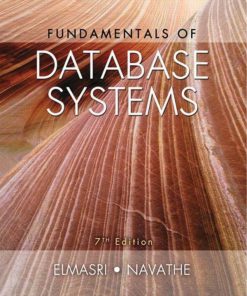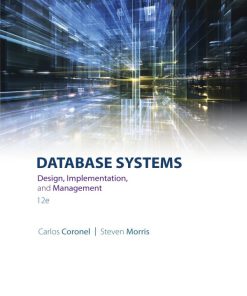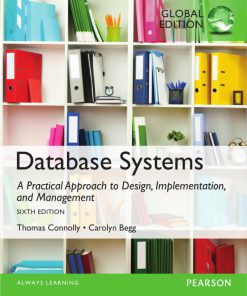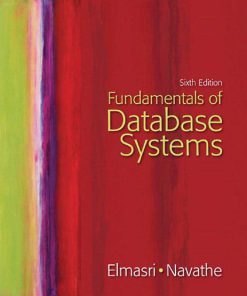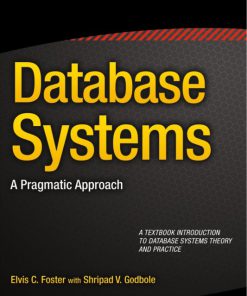Fundamentals of Database Systems 7th edition by Ramez Elmasri, Shamkant Navathe ISBN 0133970779 978-0133970777
$50.00 Original price was: $50.00.$25.00Current price is: $25.00.
Authors:Ramez Elmasri; Shamkant B. Navathe , Series:IT & Computer [478] , Tags:Computers; Desktop Applications; Databases , Author sort:Elmasri, Ramez & Navathe, Shamkant B. , Ids:Google; 9781292097619 , Languages:Languages:eng , Published:Published:Aug 2016 , Publisher:Pearson , Comments:Comments:For database systems courses in Computer Science This book introduces the fundamental concepts necessary for designing, using, and implementing database systems and database applications. Our presentation stresses the fundamentals of database modeling and design, the languages and models provided by the database management systems, and database system implementation techniques. The book is meant to be used as a textbook for a one- or two-semester course in database systems at the junior, senior, or graduate level, and as a reference book. The goal is to provide an in-depth and up-to-date presentation of the most important aspects of database systems and applications, and related technologies. It is assumed that readers are familiar with elementary programming and data-structuring concepts and that they have had some exposure to the basics of computer organisation.
Fundamentals of Database Systems 7th edition by Ramez Elmasri, Shamkant Navathe – Ebook PDF Instant Download/Delivery. 0133970779 978-0133970777
Full download Fundamentals of Database Systems 7th edition after payment
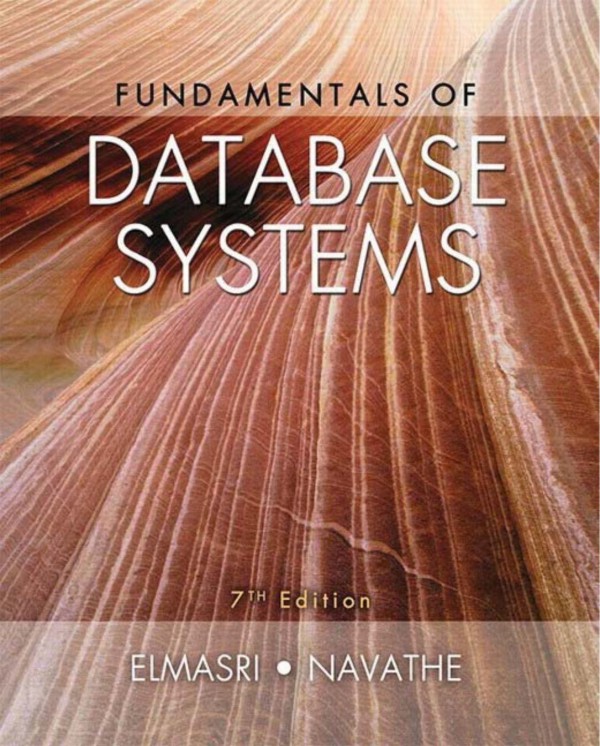
Product details:
ISBN 10: 0133970779
ISBN 13: 978-0133970777
Author: Ramez Elmasri, Shamkant Navathe
For database systems courses in Computer Science
This book introduces the fundamental concepts necessary for designing, using, and implementing database systems and database applications. Our presentation stresses the fundamentals of database modeling and design, the languages and models provided by the database management systems, and database system implementation techniques.
The book is meant to be used as a textbook for a one- or two-semester course in database systems at the junior, senior, or graduate level, and as a reference book. The goal is to provide an in-depth and up-to-date presentation of the most important aspects of database systems and applications, and related technologies. It is assumed that readers are familiar with elementary programming and data-structuring concepts and that they have had some exposure to the basics of computer organization
Fundamentals of Database Systems 7th Table of contents:
Part I: Introduction
Chapter 1: Introduction to Database Systems
1.1. Database Systems and Their Applications
1.2. Purpose of Database Systems
1.3. Components of a Database System
1.4. Advantages of the Database Approach
1.5. Data Models
1.6. Database System Architecture
1.7. Data Independence
1.8. Database Languages and Interfaces
1.9. Overview of the Database Design Process
1.10. Database Users and Administrators
Part II: Data Models
Chapter 2: The Entity-Relationship Model
2.1. Entities, Attributes, and Entity Sets
2.2. Relationships and Relationship Sets
2.3. Constraints in the Entity-Relationship Model
2.4. Enhanced Entity-Relationship Model
2.5. Mapping an ER Diagram to Relational Schema
2.6. Design Issues with ER Modeling
Chapter 3: Relational Data Model
3.1. The Relational Model
3.2. Relational Databases
3.3. Relation Schema and Relational Integrity Constraints
3.4. Keys and Foreign Keys
3.5. Relational Algebra
3.6. Relational Calculus
Part III: SQL and Query Languages
Chapter 4: Relational Database Design
4.1. The Need for Good Database Design
4.2. Functional Dependencies
4.3. Normalization: 1NF, 2NF, 3NF, and BCNF
4.4. Multivalued Dependencies and 4NF
4.5. Join Dependencies and 5NF
4.6. Domain-Key Normal Form
4.7. Denormalization
4.8. Database Design Algorithm
Chapter 5: Structured Query Language (SQL)
5.1. Introduction to SQL
5.2. SQL Data Definition Language (DDL)
5.3. SQL Data Manipulation Language (DML)
5.4. SQL Queries
5.5. SQL Data Control Language (DCL)
5.6. SQL Joins
5.7. Nested Queries and Subqueries
5.8. Views and Transactions in SQL
5.9. Integrity Constraints in SQL
Part IV: Storage and Indexing
Chapter 6: Storage and File Structures
6.1. Data Storage and File Organization
6.2. Data Representation on Disk
6.3. Data Access Methods
6.4. File Organization and Access Paths
6.5. Indexing Techniques
6.6. Hashing Techniques
6.7. B+ Tree Indexes
Chapter 7: Indexing and Hashing
7.1. Introduction to Indexing
7.2. Single-Level Indexes
7.3. Multilevel Indexes
7.4. B-Tree and B+ Tree Indexes
7.5. Hashing Methods
7.6. Bitmap Indexes
Part V: Query Processing and Optimization
Chapter 8: Query Processing
8.1. Overview of Query Processing
8.2. Query Optimization Techniques
8.3. Select Operation
8.4. Join Algorithms
8.5. Query Execution Plans
8.6. Estimating Query Cost
8.7. Query Optimization in Practice
Chapter 9: Query Optimization
9.1. Basics of Query Optimization
9.2. The Cost of Query Operations
9.3. Optimization of Selection, Projection, and Join Operations
9.4. Heuristic Optimization Techniques
9.5. Search Algorithms for Query Optimization
9.6. Join Optimization
9.7. Distributed Query Processing
Part VI: Transactions and Concurrency Control
Chapter 10: Transaction Management
10.1. Transactions and Transaction Management
10.2. ACID Properties of Transactions
10.3. Transaction States and Control
10.4. Concurrency Control Protocols
10.5. Recovery and Undo/Redo Mechanisms
10.6. Log-Based Recovery
10.7. Advanced Transaction Management Techniques
Chapter 11: Concurrency Control
11.1. The Need for Concurrency Control
11.2. Lock-Based Protocols
11.3. Deadlock Handling
11.4. Optimistic Concurrency Control
11.5. Timestamp-Based Protocols
11.6. Multiversion Concurrency Control
Part VII: Advanced Database Topics
Chapter 12: Database Design and Security
12.1. Security Issues in Databases
12.2. Authentication and Authorization
12.3. Encryption Techniques for Databases
12.4. Database Security Models
12.5. Access Control in Databases
Chapter 13: Distributed Databases
13.1. Distributed Database Concepts
13.2. Data Fragmentation and Allocation
13.3. Distributed Query Processing
13.4. Replication and Consistency
13.5. Distributed Transaction Management
13.6. Distributed Database Design
Chapter 14: Data Warehousing and Data Mining
14.1. Introduction to Data Warehousing
14.2. OLAP (Online Analytical Processing)
14.3. Data Warehousing Architecture
14.4. Data Mining Techniques
14.5. Association Rules and Classification
14.6. Data Mining Applications
Part VIII: Advanced Topics
Chapter 15: Object-Oriented Databases
15.1. Object-Oriented Database Concepts
15.2. Object-Oriented Data Models
15.3. Object-Relational Mapping
15.4. Querying Object-Oriented Databases
15.5. Object-Oriented Database Systems
Chapter 16: XML and Web Databases
16.1. XML and Its Use in Databases
16.2. XML Data Models
16.3. Querying XML Data
16.4. Web Databases and Web Services
16.5. Integrating XML with Relational Databases
Appendices
Appendix A: Relational Algebra and Relational Calculus
Appendix B: SQL Query Examples
Appendix C: Database Design Algorithms
Appendix D: Additional SQL Topics
Index
People also search for Fundamentals of Database Systems 7th:
borrow fundamentals of database systems global edition
fundamentals of database systems global edition
what is fundamentals of database systems
fundamentals of database systems syllabus
database systems syllabus
You may also like…
eBook PDF
Fundamentals of Experimental Pharmacology 7th Edition by MN Gosh ISBN 8190296507 9788190296507
eBook PDF
Fundamentals of Experimental Pharmacology 7th Edition by MN Ghosh ISBN B0CHQH36XP 9788190296507

